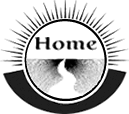 |
 |
| |
|
|
| |
|
|
| |
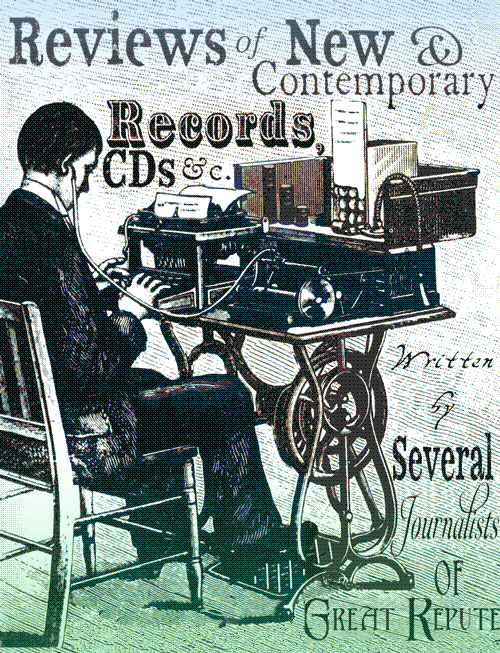 |
|
| =
September 2019 = |
|
|
| Vic Mars |
| Infinity Forms of
Yellow Remember |
| the Skiffle
Players |
| Fionn Regan |
| Gospelbeach |
| The
Cold Spells |
| Taras Bulba |
| the Cosmic
Dead |
| Mellotron
Variations |
| |
| |
| |
| |
| |
| |
| |
| |
| |
| |
| |
| |
| |
| |
|
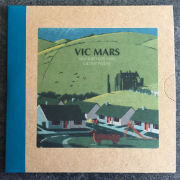
Home |
VIC MARS – INNER ROADS
AND OUTER PATHS
www.claypipemusic.co.uk
700 x numbered copies with download
code on turquoise blue vinyl/DL
This will be Vic’s third release on boutique label
Clay Pipe. Following on from 2015’s ‘The Land
And The Garden’ and last year’s very limited
cassette release of ‘The Soundtrack To The
Hospice’.
Inspired, in part, by Alfred Watkins excellent book
entitled ‘The Old Straight Track’, written in
1925 about ley lines and desire paths and also
by old photographs of Vic’s county of birth,
Herefordshire. This record investigates these
old paths, it is also informed by derelict
buildings, overgrown pathways and Holloways, so
right up my psychogeographical road really. It
was recorded with 1980’s style ‘tracker’
software, with a range of instruments that
include recorders, glockenspiels, acoustic
guitars, Korg Monopoly and Roland Juno 60
keyboards.
Vic takes us all on a bucolic pastoral journey, with
this his latest, purely instrumental album. It
starts with a visit in to town with ‘bric-a-brac
shop’, which sounds very much like a schools
project, in a good way. ‘Evacuees at Arrow
House’ is a charming pastoral reverie, which as
it progresses takes on more of an unsettling
current, due to the presence of electronics.
“Thistle and Briar” has strong melodies and adds
more percussion as it works and winds its way
through to its conclusion of foggy mellotron. “A
Nest In The Warehouse Roof” begins with bright
piano with an undercurrent of cello, upon which
various instruments such as oboe are layered (I
say oboe and cello but really I should think
that these are derived from his keyboards). The
title track “Inner Roads And Outer Paths” starts
slowly and gradually uncoils, it develops into a
woodwind, piano and acoustic tune, of gentle
reflective beauty.
“The Last Days Of The Great House” all piano and
whirring electronics map out the tune of this
song of a crumbling building, as the moss and
plants gradually establish a foothold, a
reclamation by nature. “Broken Spires And Ruined
Arches” continues this theme of growth and
decay. “Holloways” up next, they are some of my
favourite places to visit and so I was really
looking forward to hearing Vic bring them to
life, he does a fine job with a tune that’s
wistful, yet, has an unsettling quality to it.
“Paths Beyond The Towns” is charming, suggesting
a pastoral rural nostalgia, bought to life
through its application of woodwind and
electronics.
“Following The River” is a little brighter, again
highly melodic and charming, nylon stringed
acoustic guitar, picks out the melody, which is
underpinned by bass woodwind, hammered notes and
electronics. “End Of The Branch Line” has gentle
percussive tones suggesting a train in motion,
the journey being highlighted by more layered
acoustic and electronics instruments. “The Fair
Arrives” and the preset buttons dance a merry
tune over muted Morris dance bells. This
charming and lovely record ends with “Earthworks
And Trackways”, a melodic song, which perfectly
illustrates the nature of such walks. Vic has
delivered another superb album of quiet beauty.
I fully expect the record to sell out fairly
quickly, when it released towards the end of
this month.
(Andrew
Young)
|
|
|
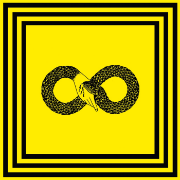
Home |
INFINITY FORMS OF YELLOW REMEMBER
– S/T
(2XLP from Cardinal Fuzz https://cardinalfuzz.bigcartel.com/)
Stop me if you’ve hear
this one before.
During Terrascope’s recent
dalliance in live music we were honoured to
bring Mugstar to the Moon in Cardiff. In fact it
almost didn’t happen. As it transpired,
Liverpool’s now veteran space rockers, about
whom we have waxed lyrically and
enthusiastically on this very virtual vellum
these many a year, were in a transitional phase
having lost half of their hitherto constant
membership and almost had to pull out. The fact
they didn’t bears great testimony to them as was
the fact they made more than a decent fist of
things on the day.
So where’s he going with
this, you’re probably thinking. Well the night
was truly saved by the local support group,
Infinity Forms Of Yellow Remember, who were not
only playing just their second gig but in the
absence of a second act on the undercard turned
in a set almost as long as that of the headline
act. And they absolutely knocked it out of the
park. Drawn from some of the region’s most
criminally overlooked acts – Witches Drum,
Dharma Violets and The Best Thing Since Powdered
Milk among them – their clever mash up of space
and garage rock and understated melody showed
they were quickly capable of evolving into very
much their own animal*.
(*As a six-piece they were also the latest in what
had quickly become a Terrascope party trick of
fitting large units – Gnod and Hey Colossus
among them – on the smallest stage in
Christendom. It’s bigger now, but that’s still
no comfort to anyone over six foot tall or
with big hair).
That was two years ago
give or take a month or so, and just as it
seemed Infinity Forms were about to join
Cardiff’s Museum of Lost Art (the extensive wing
where they keep all the really good bands who
never made it out of Womanby Street), in rides
The Cardinal (gawd bless ‘im) to give them the
documented exposure that on the strength of that
live performance and indeed this debut
recording, they so richly deserve.
To the business in hand.
It’s clear these boys are
no strangers to Hawkwind’s back catalogue.
There’s nothing at all wrong with that, of
course, and rest assured there’s much more to
them than that as we shall see. Take opener
‘Strange Flotsam On The Rising Tide’ which leads
with an acoustic guitar rumination (something of
a recurring theme as it transpires), then gently
floats off into space before firing out of the
traps on ‘Sub Sonic Dream’. Here, the energetic
fuzzed up riffing evokes the aforementioned
Hawks played by half a dozen over-excited kids
on Christmas morning, with more than a
sandblasting of Comets On Fire thrown in for
good measure. There’s even a Brainstorm-style
bridge thrown in, laying the foundation for a
sumptuous dreamy mid-section and allowing the
band catch their second breath before the
interstellar kicks back in with gusto. In
contrast ‘Surely They Know’ clips along brightly
enough, for all the world sounding like the
Beach Boys and Dandy Warhols going at it like
knives. It rocks with a keen pop sensibility and
enough hooks to snag even the most carelessly
directed of hats. Go on, try it.
The segmented lengthy
centrepiece is ‘Great Vibrating Season’, all 16
minutes of it, which waxes and wanes in an orgy
of floating, old school ambience. It gladdens
the heart, cleanses the soul and tickles the old
synapses in the most delightful way. It also
shows a band well capable of exercising
restraint when required to do so. Yes of course
it builds into something you can shuffle along
to and that ‘ol space boogie never lurks too far
below the surface, before subsiding to a
strummed acoustic coda. ‘Walk With The King’
also packs enough rarefied atmosphere to cause
nose bleeds before a sharp change of tempo
transforms it into another more than passable
Brock-buster. This lasts only as long as it
takes for someone snaps the handbrake and off
she hurtles into deep space before the engines
cut and we are again treated to such a gentle
landing that even these old ankles wouldn’t snap
on impact.
Arguably though, the
judge’s nod goes to the album’s other extended
track ‘Sun God Grave Gods’. In what might be
seen as something of a predictable pattern by
now, it starts off innocuously enough with a
see-saw drone, gradually building to a languid,
dare one say dopey-sounding mantra, the
plaintive wailing of a harmonica juxtaposing
with the eastern vibe for a surprisingly
pleasing result. These are more subtle
variations, playful guitar runs intertwining
with synth washes over a steady and gradually
more insistent rhythm combining to mesmeric
effect. A more lengthy acoustic comedown this
time and that’s yer lot.
It is often said that punk
pretty much passed South Wales by, which may
sound a little harsh but is, generally speaking,
bang to rights. Infinity’s lush debut tends to
lend weight to this impression – to borrow a
certain label’s strapline and raise them one
“it’s as if the past 45 years never happened”.
That isn’t necessarily a bad thing. Sometimes
you have to travel back to find the inspiration
to move forward. Well I’m going to be happy
enough with this for the rest of the year and
it’ll probably do me for most of the next one as
well. Disturb me only if anything else should
happen in the meantime.
(Ian Fraser)
|
|
|
|
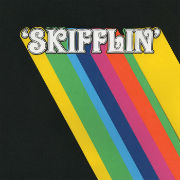
Home
|
THE
SKIFFLE PLAYERS – SKIFFLIN’
(DL
on
Spiritual Pajamas)
Many
of
us were left speechless by the tragic news of
the passing of Neal Casal at the age of 50.
The gentle, soft-spoken guitarist packed
a lot of great music in his all-too-short time
with us. Casal
had as many bands and projects as most of us
have socks. Some
were big and famous, and some were small, not to
mention 12 solo albums, and it would take pages
to detail all of them.
I thought I’d pick something out of his
gigantic catalogue for your perusal, this 2016
album Skifflin’ by The Skiffle Players.
Maybe you’ve heard it, maybe not.
Casal
was
equally at home with jam-friendly bands like the
Chris Robinson Brotherhood and straightforward
song acts such as this.
The Skiffle Players is Casal; folk
writer, singer and guitarist Cass McCombs; Dan
Horne, who was with Casal in Circles Around the
Sun; and multi-instrumentalist Farmer Dave Scher
and drummer Aaron Sperske, both from Beachwood
Sparks. Though
they would go on to release the EP Piffle Sayers
and a second album, Skiff, this debut is their
best.
Although
you
won’t hear any tea chests or washboards, there’s
still a decidedly acoustic, or light electric
sound to the record.
Casal dearly loved The Grateful Dead, and
embodied a lot of his projects with a Dead
ethos, which is clearly present in Skifflin’.
Often times, the album has an authentic
Workingman’s Dead/American Beauty sensibility,
and that ain’t no bad thing.
Most
of
the songs are Cass McCombs compositions, with a
few exceptions being traditional number “Coo Coo
Bird,” murder ballad “Omie Wise,” and Texas
bluesman Henry Thomas’ “Railroadin’ Some.”
(Both “Coo Coo Bird” and “Railroadin’
Some” employ a chugging train rhythm).
Then there are the shimmering tracks “Til
Stone Day Comes” and “When the Title Was Wrote.”
Someday,
if
your descendants ask you “Grandpa, what was
meant by a ‘laid back West Coast vibe?’” you can
put on “Til Stone Day Comes.”
Question answered.
“When the Title Was Wrote” is ’70 Dead
meets The Flying Burrito Brothers somewhere off
the Pacific Coast Highway. Casal’s
sublime
playing illuminates the songs and gives them an
abiding beauty.
The love ballad “Always” is slightly
out-of-step with the style of the rest of the
album, but you’ll get no complaints here,
because it sounds like George Harrison and Bob
Dylan’s “I’d Have You Any Time,” and again
Casal’s tasteful guitar accents lift it to
another level.
Skifflin’
was
but one of the many leaves on Neal Casal’s tree,
now fallen. He
leaves behind both an impressive legacy and a
sad void.
(Mark
Feingold)
|
| |
|

Home |
FIONN
REGAN - CALA
(LP/CD/DL
on
Abbey
Records)
Irish
folk
troubadour Fionn Regan brings us this, his sixth
album. Cala
is Spanish for “cove,” and watery imagery
abounds in this lovely release.
Recorded in his home in coastal Bray
outside Dublin, Regan’s songs are ethereal and
soothing. He
has a delightful fingerpicking style, his vocals
are calm, and the songs dreamy.
Weighing in at a concise 34 minutes,
Regan wastes no time at all in the 10 songs.
Cala
is
also one of the finest home recordings I’ve
heard. Yeah,
it’s folk music, just a guy and a guitar, right?
But Regan supplies overdubbed background
vocals with lots of oohs and ahhs and the
occasional falsetto swoops, plus effects and
tasteful soundscapes to sand the edges off this
most professional sounding record.
The locales in his travelogue include the
Irish coast, Spain, and New York City.
Regan
opens
“Collar of Fur” with “Wear this crown of light
for you/on this August moon/Bring your voice of
pearl to sing,” with imagery of doors that open
to the beach. The
rest of the album flows naturally from there,
like a tidal stream to the sea.
There
is
a wonderful run of three songs in the album’s
second half; title song “Cala,” “Brass Locket,”
and “Hunting Dog.”
In each, Regan starts with tender
melodies and simple tales of plain folk, and
pours on the vocal ahhs and atmospherics to
tremendous effect.
Listen to the charming “Brass Locket” and
feel all your worldly cares melt away.
Regan has a way of sounding like he’s
just singing to himself, or to you, or to
everyone at the same time.
The
swirling,
ghostly “Under the Waves/Tokyo” rounds out the
set from whence we came.
“I want to sleep with you for a day,
under the waves” sings Regan.
As the song transitions to the “Tokyo”
section, a small chorus meets the beautiful
guitar playing, as Regan dreams of taking flight
to the East.
Cala
is
a gorgeous, autumnal album to lose yourself in,
as placid and soothing as the ocean waters Fionn
Regan describes, with gentle waves to match his
ethereal voice and playing.
It’s timeless, unforgettable work that
touches the soul.
(Mark
Feingold)
|
| |
|
|
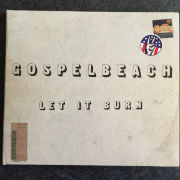
Home
|
GOSPELBEACH
–
LET IT BURN
Alive Natural Sounds records Vinyl/CD/DL
This record’s a real peach of an album, but one that
is tempered by the tragic loss of guitarist/
vocalist Neal Casal, a man whose career I have
followed since he first burst onto the scene
with his wonderful debut album “Fade Away
Diamond Time”, which marked him out as an
exceptional talent in the vast Americana genre.
This album is the fourth release since 2015’s
“Pacific Surf Line”, and is the one to promote
them into the big league, if there was any
justice in this old world. The songs on the
album were written by Brent Rademaker and Trevor
Jimenez.
“Bad Habits” is a glorious opener, a solid rhythm
section (consisting of Ben Redell on bass and
Trevor on drums), map out and anchor the song,
which is brought to life by rocking electric
guitars tempered by Mellotron fills. “Dark
Angel” begins with a blistering guitar figure
with oodles of organ, chiming guitar and sounds
very much like classic Tom Petty. “I’m So High”
is a fairly straightforward boogie-based song
which duly rocks out. Thing slow down with “Baby
(It’s All Your Fault)”, a delicate piano led
ballad, decorated with beautiful harmonies. “Get
It Back” is terrific, it tells the story of a
fading star, a highly melodic song with more
piano and Mellotron, it’s also quite English
sounding and dare I say it, a little Beatlesque.
“Fighter” is another pretty straight up rock song,
with some terrific guitar breaks. “Unswung” is a
gem of a song, great lyrics, plenty of changes,
rinky dink piano, plenty of ‘western swing’
style twin guitars by Neal and Brent, ending up
with a glorious guitar solo. “Good Kid” tells
the story of teenage love, drugs and escape.
Electric piano lends it a kind of Steely Dan
vibe, with the guitars and vocals channelling
Crazy Horse. “Nothing Ever Changes” is a solid
choogling rocker, with plenty of organ. The
title track “Let It Burn” sees Brent and Neal
laying down some fine guitar, Jonny Niemen’s
Fender Rhodes and Mellotron filling in the gaps
as it heads heavenwards with an epic spiralling
guitar solo. Final track “Hoarder” documents
more bad habits and proves to be a fine country
rock song, informed by slide guitar and piano.
Who knows what’s next for the band, losing a key
member is always going to be hard, especially
one as brilliant as Neal. I hope they do, as the
band’s now really hitting their stride.
(Andrew
Young)
|
| |
|

Home |
THE
COLD SPELLS –
INTERSTITIAL Available
on
Vinyl/CD/DL
www.garddunord.kudosrecords.co.uk
This is second album by The Cold Spells, whose
eponymously titled debut album has received
plenty of plays over the last year. The band
comprise of Tim Ward: vocals, guitar and synth
and Michael Farmer: vocals, pianos, synths,
organ and harmonium. It was an eerie album full
of wintery flavoured psychedelic folktronica.
Think Barrett’s whimsical nursery style songs;
add a touch of Hitchcock and a big helping of
Tunng.
Estuary sounding vocals, finger picked acoustic
guitar and electronica announce album opener
“Leviathan”, which fades to the sound of lapping
waves. “Codger’s Lament”, follows a tinker’s
tale of hard times and thrift. “Mayday” works
well, over reasonably happy music the vocals
tell of madness, isolation and confusion.
“Landscapes” is a real grower; it’s
psychedelically inclined. Playful lyrics about
size, of being alone in the world, of ciphers,
compasses and sun light, to a bed of pulsing and
whirring electronics, excellent stuff indeed. “I
Hate It When You’re Sad”, is indeed a sad song;
one that wouldn’t be out of place on one of
Robin Proper Shepherd’s band Sophia’s songs.
I get Pentangle immediately with the title track
“Interstitial”, albeit a Pentangle with synths,
it’s quite short and almost instrumental. “For
All Of Us Sorry Travellers” is my favourite song
on the album, a cracking tale of suicide, and of
making a deal with the devil. How many songs
mention that misery loves company, oh well
here’s another to add to the list. “The Blaze”,
is a catchy song, it rises and falls, informed
by walking bass, organ, acoustic guitar and
synth. “Here We Go”, is dense and knotty. It’s
the most Tunng like moment on the album,
acoustic guitar, treated vocals and piano with
oodles of percussion and synths. “You Play My
Mistakes”, ends the album with a laconic song
for the wee small hours.
(Andrew
Young)
|
| |
|
|
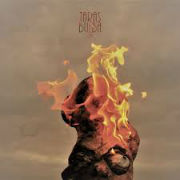
Home
|
TARAS
BULBA
- ONE
(LP on Riot
Season
Records)
It was sad to see the dimming of the day for
Earthling Society who delivered a wonderful
series of records through the years, finishing
in this writer’s humble estimation on a career
high with the superb ‘MO – The Demon’. It was a
record that pointed in new directions for
Earthling Society’s music and rather than
leaving the unfulfilled promise of sound
adventures that could have been, Taras Bulba
have risen from the ashes with Fred Laird and
Jon Blacow taking those maps and charts to
continue the journey into a new musical space
full of imagination and invention. By the way
that’s the last I’ll say about Earthling Society
because this is a new project and deserves to be
judged on that basis.
‘One’ was recorded between September 2018
and May 2019 in various places on home recording
equipment. This nomadic recording process is
also reflected in the rich diversity of
influences from musical styles, traditions,
countries and cultures to be heard and enjoyed
in the Taras Bulba sound.
The record starts with ‘Hashish’ and the sound of an
unwinding, densely layered dream state raga that
also has echoes of traditional European folk in
its claustrophobic eastern tinged psychedelia.
It’s a wonderful atmospheric opener to draw the
listener into the world of Taras Bulba.
‘Moroccan Waves’ follows and is in essence a
folk dance with a meaty riff propelled by the
heavy and hearty beat of Jon Blacow’s drums. It
once again creates a hybrid of Eastern desert
ambience with hints of European folk melodies.
Fred Laird’s joyful electric guitar solo dances
through a hazy soup of desert sound occasionally
accompanied by high pitched and dramatic
synthesised strings. The final third of the
track is a strummed acoustic section with
recorder floating over the jaunty melody. There
are hints of Plant and Page’s more adventurous
moments and strong desert blues influences at
play but also the folk fusion sensibility of the
Incredible String Band to bring it all together
into a coherent and original piece of music.
With ‘On Mt. Kailash’ we move to more ambient
territory and a much more contemplative sound
that recalls Popol Vuh and other Kosmische
pioneers. It has a spare and meditative beauty
after which the direction of travel once again
changes with ‘I Hadit, U Nuit’, a joyful space
rocker built on shuffling jazzy rhythms, tense
drones and a soaring guitar solo. There is an
echo of ambient or triphop/dance music in the
repeating keyboard motif that emerges through
the track which somehow manages to remain
distinct in the eye of the storm. ‘Rising
Lazarus Blues’ is a lengthy track of two halves.
It starts as an acoustic blues with a lonesome
wailing vocal and an almost dirge like rhythm
before a blissful Kosmische guitar and keyboards
section takes the mood to a higher, ecstatic
place. ‘The Neon Midnight’ returns to a darker,
mysterious, avant garde ‘thriller noir’ sound
with its picked acoustic motif, sax notes,
squalls of noise and music box/Eastern
percussion working in a cinematic harmony. With
another distinct change of direction we get
‘The YO-YO Man’ where avant funk rhythms
and basslines put down a fine groove and
underpin an improvised fusion of synth and
guitar sounds flying in all directions, barely
held together by a repeating chanted vocal of
the title. It’s different to anything else on
the record but none the worse for that. To end
we get ‘Goin’ West’ which returns to a more
atmospheric Kosmische informed sound but takes
it to a different place with a subtle dub
undercurrent in the mix.
This is a wonderful record that really delivers a
melting pot of sounds with great intelligence,
invention and style. Each play brings something
new and rewarding to the experience and is a
rich, exotic and occasionally ecstatic listening
pleasure. I recommend it to your ears very
highly.
(Francis
Comyn)
|
| |
|
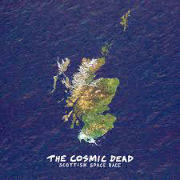
Home |
THE
COSMIC DEAD –
SCOTTISH SPACE RACE
(LP/CD on Riot
Season
Records)
It’s been two years since the last recorded encounter
with The Cosmic Dead on the excellent ‘Psych Is
Dead’ and I’m happy to confirm that the time
since that release has been spent very well
indeed. ‘Scottish Space Race’ consists of four
lengthy side long tracks recorded in Glasgow and
it highlights the joyful mix of experiment and
exhilaration that I’ve come to know and love
from previous releases and live shows.
‘Portal’ kicks things off with a jumble of
electrically charged buzz and drone with a
flurry of cymbals. Its spacey synths slowly grow
more intense and urgent with the cymbals
approaching minor blizzard status. From this
‘cosmic’ introductory section the drums kick in
hard with heavy riffs, constant waves of slide
guitar and a distant vocal in a chanting,
occasionally screaming style that gradually
build up to a peak of unhinged riffing, squalls
of noise, frantic guitar soloing and of course a
little screaming. It’s a joyful mix of slow
building intensity with the ferocity, speed and
abandon of a crushingly heavy psychedelic freak
out jam. It’s simply exhilarating and rather
wonderful over its 21 minutes.
Where do you go after such an opening jaw dropper?
The answer is ‘Ursa Major’, another side long
long trip through a (thankfully) calmer musical
galaxy. The other ‘Dead’ we all know and love
spring to mind with the initial guitar workout
and there is a more spacious psychedelia that
has an Americana infused Krautrock rhythm and
feel which becomes more pronounced as the track
gathers steam and pace but there are also big
hints of Television in the way the guitar solo
builds and builds
to a peak of barely controlled intensity.
This is a territory that recent Chris Forsyth
recordings have mined very well and The Cosmic
Dead have equally struck gold here.
The title track, a relative hit single length at 12
minutes has Sabbath-esque crunchingly heavy
riffs, squalls of noise and a shouty repeating
vocal line of ‘Can You Dig It?’ all wrapped up
in a metallic punk-psych monster. All the
ingredients are present and correct for this
being a favourite sing along bounce along song
at gigs.
The final side ‘The Grizzard’ returns to long form
(over 24 minutes) and once again starts off with
crunching riffs wrapping around a storm of
noise, this time in a somewhat Swans like way
where the noise, repetition and general
heaviness become almost hypnotic. The track
gathers pace after a few minutes and takes on a
heavier space rock feel where the heavy shuffle
of drums and guitar soloing propel the track on
a bed of dramatic synth noise that encourage a
shake of the head quite nicely . There’s a touch
of a more urgent Hawkwind in the feel of the
guitar and general atmosphere for a while but as
the track moves more towards an ecstatic chaos
it’s all The Cosmic Dead’s own wonderful and
thrilling trip to the edge of abandon. At around
the halfway point the rhythm becomes punchier
and a shouted vocal again comes into the song
but the general intensity and drive by no means
lets up, it simply moves into a different guise
until a climax of pulverising metallic
riffing and noise leaves the shell shocked
listener to pick themselves up if they still
can.
This is an absolute gem of a record and all these
tracks are begging to be seen and heard live so
if you see a gig near you get to it. In the
meantime I look forward to the Scottish Space
Programme launching this record as a greeting to
other planets – who will dare to answer the
message!
(Francis
Comyn)
|
| |
|

Home
|
MELLOTRON
VARIATIONS – MELLOTRON
VARIATIONS
(LP/DL
on
Spaceflight
Records)
For
a
great many years, I thought, why doesn’t
somebody make an album entirely on
the Mellotron? Then
it finally started.
Papernut Cambridge released Mellotron
Phase: Volumes
1 and 2 in 2017 and 2018,
respectively. Calibro
35’s Massimo
Martellotta released One Man Sessions, Vol. 3:
One Man Orchestra in 2018 (though not
technically a Mellotron album).
There may be others I’m not aware of.
And now we have this new release,
“Mellotron
Variations.” If
all-Mellotron albums are
to be a regular going concern, I raise my glass
to toast this new/old genre.
Interestingly,
“Mellotron
Variations” is listed as both the album title and the artist. But we know
who
the artists really are:
it’s John
Medeski (Medeski Martin & Wood), Pat Sansone
(Wilco), Jonathan Kirkscey
(composer and cellist for the Memphis Symphony
Orchestra), and Robby Grant
(Vending Machine).
The project dates all
the way back to 2016 when Robby Grant enlisted
Jonathan Kirkscey for a one-off
duo concert in Memphis that was captured in the
excellent “Duets for Mellotron”
album in 2017 (one more to add to the list
above). Pat
Sansone was in the audience for that
performance, and with he and later Medeski
joining the fold, and the help of a
grant from the National Endowment for the Arts,
Mellotron Variations was born.
The project was another live concert,
held in
Memphis in April 2018, with all four musicians
facing each other onstage in the
round playing Trons amid trippy visuals.
The idea to release an album came later
when the musicians liked the raw
initial recordings; this LP is basically the
live recording from that
performance. But
you wouldn’t know it,
because it was recorded using the direct output
of the Mellotrons, with no
crowd noise. It
sounds for all the world
like a studio album (Kirkscey is said to have
spent about 100 hours mixing and
editing.) As
a final note, the concert
was also filmed, which will premiere on November
8th.
The four already have a couple of
follow-on
performances lined up later this year, and have
signaled they’re open to do
more.
So
how’s
it sound? Well,
it’s interesting
that the artists noted above who’ve contributed
to this genre have sometimes
taken different approaches.
Martellotta
seems to be the only one who aimed for
reproducing classical symphonic sound
(to spectacular ends, I might add).
The
others, including this, seem to have landed
compositionally somewhere between
library music, ambient and soundtrack.
But here’s where the “variations” in
Mellotron Variations come in.
While the others stick primarily to the
authentic original instrument sounds from the
Streetly Electronics library,
this one has plenty of those, but also has many
sounds that have been
stretched, squished, discombobulated,
compressed, expanded, compacted, stomped
on, and otherwise modulated until they sound
nothing like organic instruments,
and more like synths.
Some might applaud
the creativity in this approach, while others
might think that defeats the
purpose of the Mellotron.
Anyway, part
of the fun of these records is playing spot the
original instrument, which is a
little harder on this record, but still fun.
Opener
“Waltzing
Riverbed Way” employs some nifty Mellotron
guitar, clarinets,
accordion, and of course, strings, in something
that sounds out of Zorba the
Greek. “Agent
Cha Cha” is exactly what
it sounds like, secret agent music to a cha cha
rhythm, with flute, strings, Mellotron’s
rhythms and fills, and liberal use of the pitch
bend wheel. “Roller
Rink” is an up-tempo piece which uses
electric guitar, cello, flutes, and voices.
“Went Home to Meet Konrad” is a gloomy
mood piece with some of those
unrecognizable synth-like instruments.
With
“Into the Sunrise,” we have some Wurlitzer along
with strings and accordion.
For
“Pulsar,”
we return to secret agent music, albeit with
some very strange sounds
in the background like a dragon
hyperventilating.
For a live recording, the arrangements
between the four musicians are very interesting
and always changing.
“Dulcimer Bill” is my favorite; the style
is
all over the place, sounds Asian at times,
flamenco at others, and also the
closest at other times to traditional prog/rock
Mellotron, landing somewhere
between the Moodies “In Search of the Lost
Chord” and “On the Threshold of a
Dream.”
“143
i
Love You,” written by Kirkscey, is dedicated to
Fred Rogers, Mr. Rogers of
children’s TV fame.
Kirkscey scored the
2018 documentary about Rogers, “Won’t You Be My
Neighbor.” The
track is somewhat dark, and reminds me
naught of Mr. Rogers - maybe a horror movie
about him - but it’s still
enjoyable. The
finale “Turtle Monk” is
again heavy, dark and creepy, dominated by a
ghostly church organ, a sawing tuba
on the low end, and some trippy spaceship
effects. It
could’ve had a home on a 70s album by Isao
Tomita.
“Mellotron
Variations”
is a bit different from other albums of the
sort, and well worth
your time. I
plan to track them down at
one of their performances later in the year.
(Mark
Feingold)
|
|
|
| |
|
|
|
|
 |
|

